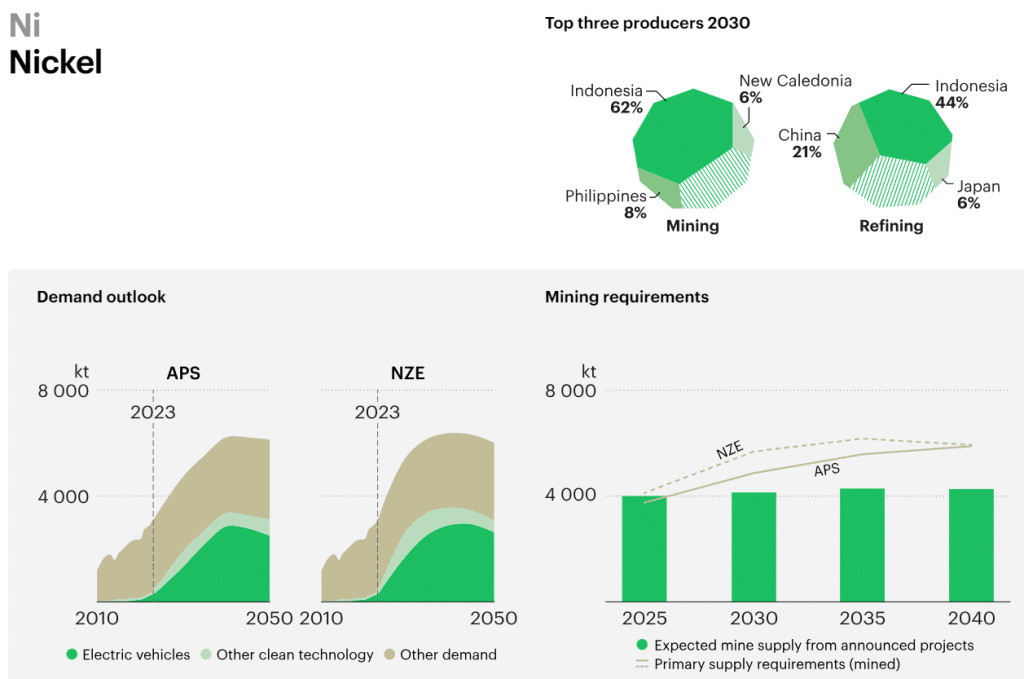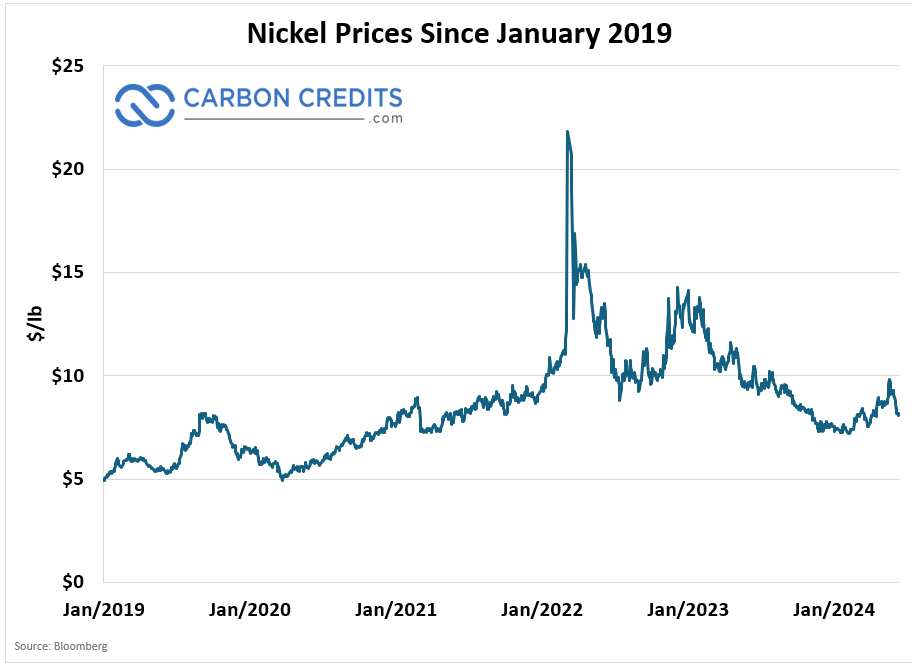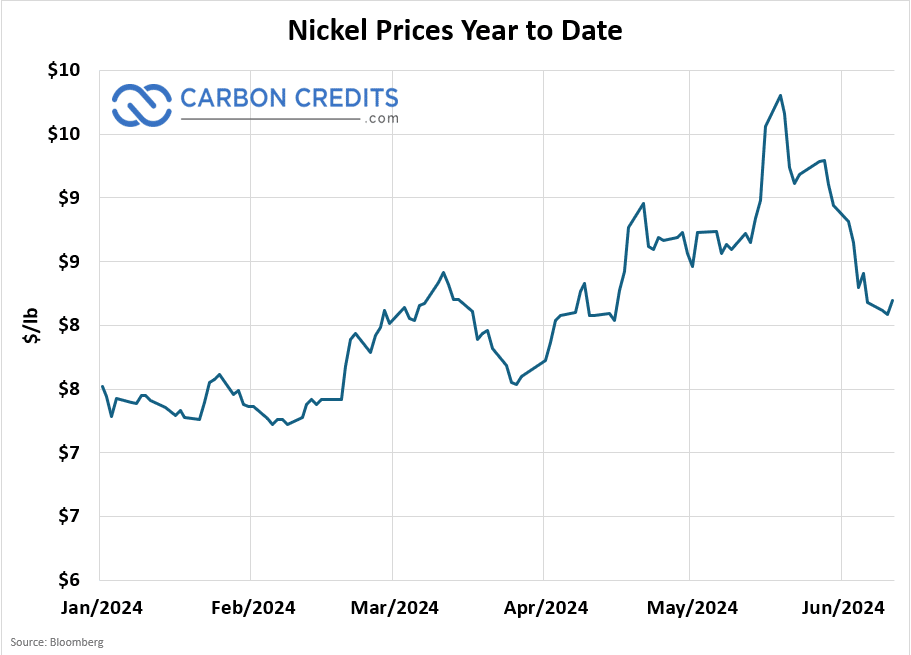In the push for energy transition and increasing net-zero commitments, demand for clean energy technologies intensified, driving up the need for critical minerals. Among these, nickel prices stand to benefit as one of the key elements used in batteries for electric vehicles (EVs).
In the first quarter of 2024, primary nickel producers significantly increased their output, leading to an oversupplied market, while mined nickel producers reduced their supply. According to S&P Global Market Intelligence data, the top five primary nickel producers produced 11.7% more output compared to the previous year.
Primary nickel includes refined nickel for electric vehicle batteries and nickel pig iron and ferronickel for steelmaking. Notably, PT Merdeka Copper Gold and Nickel Industries, both operating in Indonesia, saw the largest increases.
Nickel Prices Plunge Amid Supply Surge
The rapid expansion in Indonesia’s nickel industry has contributed to market oversupply. This leads to significant nickel price declines from the peaks of 2022 and 2023, as seen below.
The London Metal Exchange (LME) cash price for nickel was $17,790.40 per metric ton on June 7. This reflects a massive 42% drop from the 2023 high of $30,958/t on January 3.
The price also represents a 63% decrease from the 2022 high of $48,241/metric ton. Although nickel prices rose since early 2024 due to sanctions on Russian metal and protests in New Caledonia, they have since decreased but remain over 8% higher than at the beginning of the year.
The primary nickel surplus, driven by increased supply from Indonesia and China, has limited the upside for prices, with LME stocks reaching a two-year high on May 29. Consequently, some producers have announced plans to close operations or reduce output.
- PJSC MMC Norilsk Nickel, one of the top five primary nickel producers, reduced its production by almost 10%.
Conversely, the top five producers of mined nickel decreased their output, producing only over 17,000 metric tons in the first quarter. Mined nickel includes metal in ore.
Nickel Overload: Indonesia’s Surge Creates Market Turbulence
Indonesia, the Philippines, Russia, New Caledonia, and Australia were among the largest nickel-producing countries in 2023, according to GlobalData.
As of January 2023, global nickel reserves were estimated at 102.1 million tonnes, according to a GlobalData report that cites US Geological Survey data. The majority of these reserves are located in Indonesia and Australia, each accounting for 20.6% of the global total.
Other significant reserves are found in Brazil (15.7%), Russia (7.3%), New Caledonia (7%), and collectively in the Philippines and Canada (6.9%).
During the third quarter of 2023, average global nickel prices were $22,942 per metric ton, which was 11.6% lower than the same period in 2022. This price decline is attributed to weak demand from China’s battery sector and an increasing nickel supply, particularly from Indonesia.
The report forecasted a further decrease in nickel prices by 14% in 2023 and an additional 10% in 2024, primarily due to the expected rise in supply from Indonesia and the Philippines. However, it is anticipated that the growing demand for electric vehicles (EVs) will boost global nickel prices in 2025.
Nickel’s Role in the Global Energy Transition
Nickel, a versatile metal long used in currency and stainless steel, is now playing a significant role in the energy transition. The International Energy Agency (IEA) predicts a 65% increase in nickel demand by 2030, driven by the growing need for resources in clean energy technologies.

A meta-analysis of reports on this trend indicates that clean energy technologies are emerging as the sector with the fastest growth in demand for nickel and other critical minerals.
However, the nickel industry, often associated with environmental damage, faces the dual challenge of increasing production levels while enhancing sustainable practices.
Nickel’s importance in energy storage technologies has been established for many years. Its ability to improve storage capacity at a low cost was instrumental in miniaturizing batteries, enabling the portable electronic devices we use today.
Currently, nickel is being used in increasing quantities in the cathodes of lithium-ion batteries for electric vehicles (EVs), improving their performance and helping to overcome a major barrier to EV adoption: limited range.
At the start of the decade, only 4% of nickel produced globally was used in car batteries. But this figure could rise to as much as 40% by 2030, as bans on internal combustion engine vehicles approach in many markets.
The demand for nickel is not only being driven by the EV market but also by the broader energy transition. Nickel is required for high-performance alloys used in wind turbines and solar panels, as well as for catalysts for green hydrogen production.
According to the International Energy Forum’s (IEF) analysis, annual demand for nickel driven by the energy transition could increase from less than 1 million metric tons today to between 2 and 5 million metric tons by 2050.
Balancing increased nickel production with sustainable practices will be essential as the world continues to shift towards cleaner energy solutions. The industry’s ability to meet this growing demand while maintaining environmental integrity will play a pivotal role in the successful transition to a low-carbon future.




